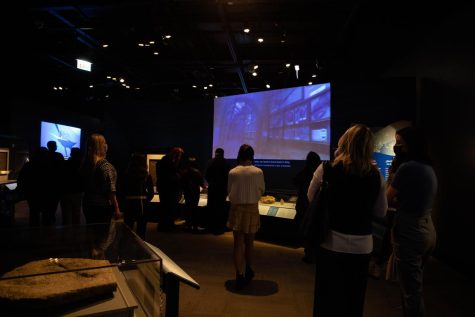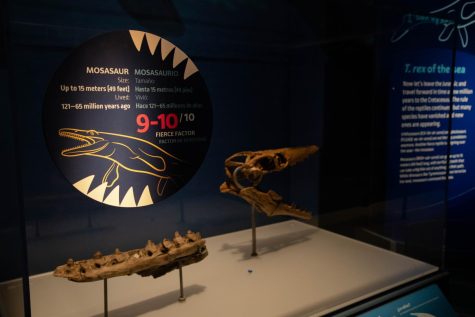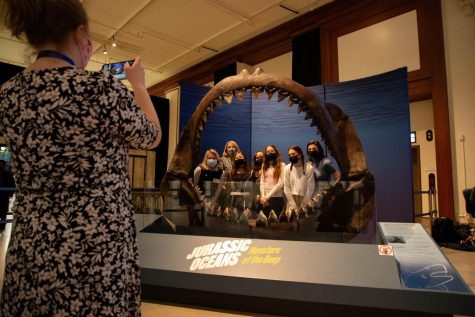New Field Museum exhibition preys upon visitors’ prehistoric curiosities, maxes out the ‘fierce factor’
March 10, 2022

Ever wondered what life was like when the dinosaurs roamed the Earth? What about the creatures that once lived in the ocean?
The unhinged jaw of the megalodon, an extinct shark that lived millions of years ago, is displayed with its sharp teeth right as visitors walk into “Jurassic Oceans: Monsters of the Deep,” the newest exhibition at the Field Museum.
The exhibition, curated and developed by the National History Museum, London, dives deep into the ocean during the Jurassic era, showcasing full scale skeletons and more than 100 fossils of reptiles, crocodiles and sharks that once ruled the sea.
The National History Museum, London, provided the fossils to the Field Museum, 1400 S. Lake Shore Drive. Viewers are allowed to interact with and touch the fossils to get a better understanding of just how ferocious these creatures were. The displays are presented in both English and Spanish.

The exhibition opened Feb. 25 and will run through Sept. 5.
Chicago is the first stop of the American tour for the Jurassic Oceans exhibition.
“It was a really exciting addition to be able to bring it in here temporarily to let our visitors see more in-depth and greater variety of these creatures,” said Marie Georg, a senior exhibition developer.

Displayed on the walls are computer-generated animations of what these creatures once looked like when they roamed the oceans. Each display showcases the creature’s “Fierce Factor,” showing from 1-10 how ferocious the creature was.
“Some of the things that are really amazing are the sizes of some of these specimens,” Georg said. “You would never expect to see a fish that has just the tail fin as big as my arm span. It is absolutely enormous.”
Another key feature of the exhibition includes a life-scale skeleton of the Futabasaurus, which reaches up to 22-feet long.
“Some of these things, you may have seen pictures of them before in a book, but to see the real specimens in real life, you can just see how enormous their teeth were, how enormous their fins were and how ferocious they really were,” Georg said.

The exhibition showcases the latest scientific research of how these Jurassic creatures have evolved. Visitors can compare these extinct specimens to the replicas of marine animals — sea snakes, turtles, dolphins and whales — living today.
Jurassic Oceans is a ticketed exhibition and requires the purchase of a Discovery or all-access pass. Tickets are $26 for a Discovery pass and $32 for All-Access Pass for Chicago residents. There are discounts for children, students and senior visitors at checkout.
“All the exciting things about dinosaurs that kids love, adults love, too,” Georg said. “This really is something where you can dive in and get that wonderful feeling of seeing these creatures and imagining what they might have looked like when they were alive.”
For more information, visit the Field Museum’s website about the exhibition, and visitors are encouraged to tag @fieldmuseum and #MonstersOfTheDeep when taking the deep dive under the ocean.







